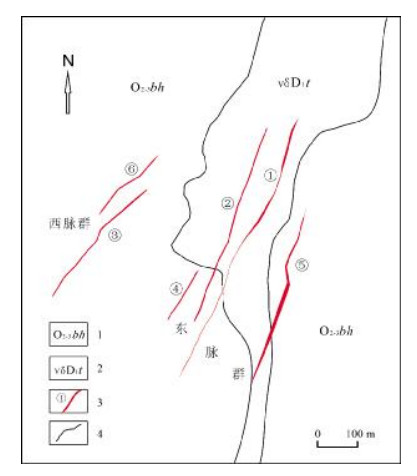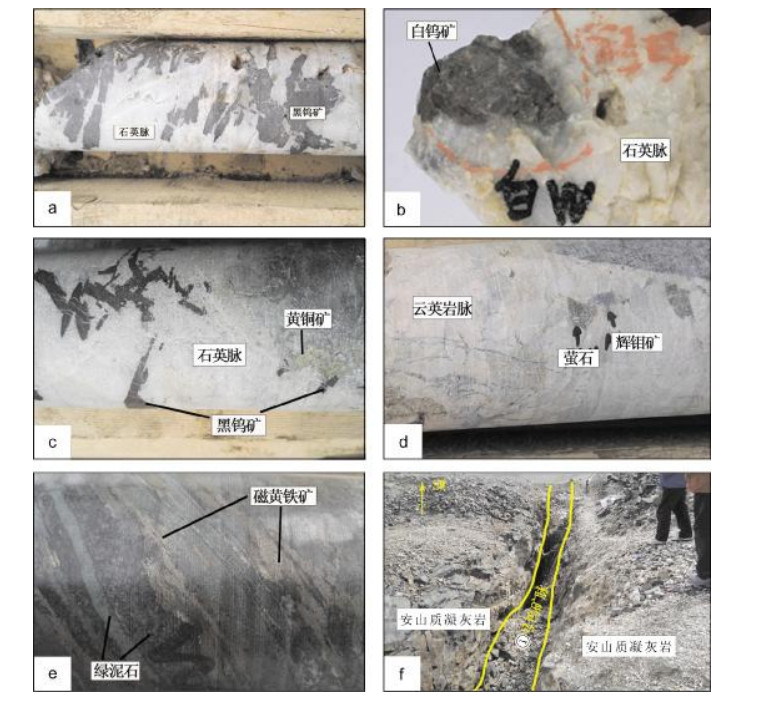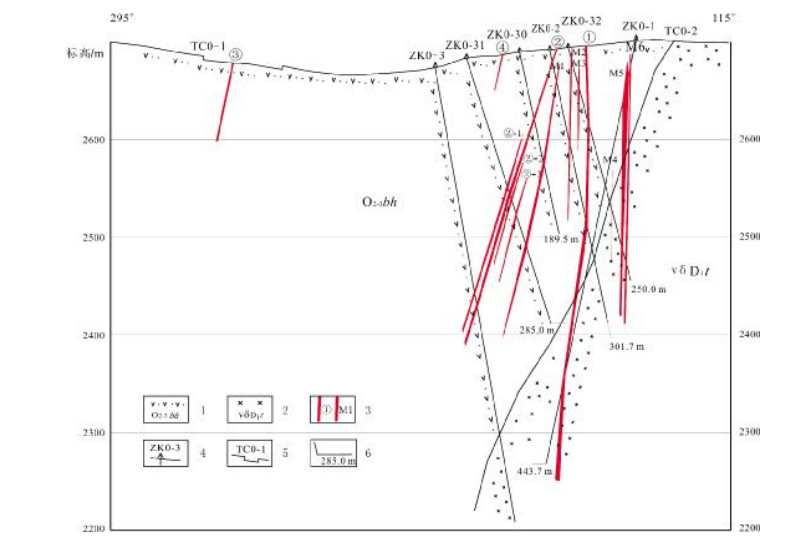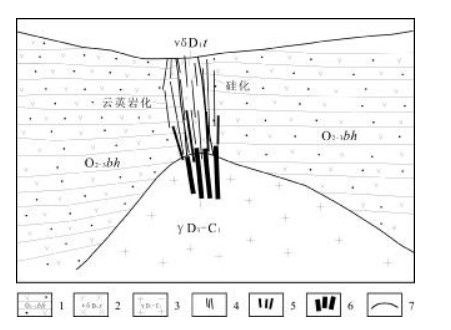GEOLOGICAL CHARACTERISTICS AND GENESIS OF THE TSUNKHEG TUNGSTEN DEPOSIT IN ALTAY AREA OF WESTERN MONGOLIA
-
摘要:
苍希格钨矿床位于蒙古国西部阿尔泰钨-钼-铜-铅-锌-银多金属成矿带内.矿体围岩为中-上奥陶统巴赫留克组火山沉积岩及早泥盆世陶伊陶古什杂岩体,矿体呈脉状、似脉状、透镜状产出.围岩蚀变主要有硅化、云英岩化、萤石化、钠长石化、绿泥石化和碳酸盐化,其中硅化、云英岩化及萤石化与钨矿化关系密切.金属矿物主要为黑钨矿、白钨矿、磁黄铁矿、黄铜矿、黄铁矿、辉钼矿、辉铋矿、闪锌矿,矿物组合在水平和垂向上均具有一定的分带.初步分析认为,苍希格钨矿床为与海西期中酸性岩浆侵入有关的中高温热液石英脉型钨矿床.
Abstract:The Tsunkheg tungsten deposit is located in the Altay W-Mo-Cu-Pb-Zn-Ag polymetallic metallogenic belt of western Mongolia. The wall rock of orebody is the volcanic sedimentary rock of Middle-Upper Ordovician Bakhriuk Formation and Early Devonian Taitaogushi complex, with the orebody occurred as vein, vein-like and lenticular forms. The wall rock alterations mainly include silicification, greisenization, fluoritization, albitization, chloritization and carbonatization, among which the former three are closely related to tungsten mineralization. The metallic minerals are mainly wolframite, scheelite, pyrrhotite, chalcopyrite, pyrite, molybdenite, bismuthinite and sphalerite, and the mineral assemblages have a certain zonation both horizontally and vertically. It is concluded from the preliminary analysis that the Tsunkheg tungsten deposit is of meso-hydrothermal quartz vein type, which is related to the intrusion of Hercynian acid-intermediate magma.
-
Key words:
- geological characteristics /
- genesis /
- Tsunkheg tungsten deposit /
- Altay metallogenic belt /
- Mongolia
-

-
图 1 蒙古阿尔泰地区大地构造及主要矿床分布简图(据文献[6]修改)
Figure 1.
-
[1] 李俊建.蒙古地质矿产概况[M].天津:天津科学技术出版社, 2013.
[2] 沈光银.蒙古西北部金多金属矿床地质特征及找矿前景[J].矿产勘查, 2013, 4(2):219-223. doi: 10.3969/j.issn.1674-7801.2013.02.015
[3] 彭素霞, 李永, 陈隽璐, 等.阿尔泰成矿带首次发现中型白钨矿床[J].中国地质, 2018, 45(5):1080-1081. http://d.old.wanfangdata.com.cn/Periodical/zgdizhi201805018
[4] 肖伟, 王义天, 江思宏, 等.南蒙古及邻区地质矿产简图及地形地貌特点[J].地球学报, 2010, 31(3):473-484. http://d.old.wanfangdata.com.cn/Periodical/dqxb201003022
[5] Graupner T, Kempe U, Dombon E, et al. Fluid regime and ore formation in the tungsten (-yttrium) deposits of Kyzyltau (Mongolian Altai):Evidence for fluid variability in tungsten-tin ore systems[J]. Chemical Geology, 1999, 154(1/4):21-58.
[6] Kempe U, Belyatsky B V. Direct isotope dating of W (-Y) mineralization at Kyzyltau (Mongolian Altai):Preliminary results[J]. International Geology Review, 2000, 42(5):470-480. doi: 10.1080/00206810009465092
[7] 李俊建, 刘新秒.蒙古地质矿产研究进展[M].天津:天津科学技术出版社, 2013.
[8] 叶天竺, 吕志成, 庞振山, 等.勘查区找矿预测理论与方法[M].北京:地质出版社, 2014.
[9] 张发山.蒙古国巴彦乌列盖省乌兰乌拉地区钨钼矿床地质特征及成矿条件[J].地球, 2014(11):106-107.
[10] 徐繁昌, 李葆华, 李表鹏, 等.赣南钨矿类型划分及其成矿流体特征[J].地质与资源, 2016, 25(4):339-344. doi: 10.3969/j.issn.1671-1947.2016.04.006 http://manu25.magtech.com.cn/Jweb_dzyzy/CN/abstract/abstract8655.shtml
[11] 聂凤军, 江思宏, 白大明, 等.蒙古国南部及邻区金属矿床类型及其时空分布特征[J].地球学报, 2010, 31(3):267-288. http://d.old.wanfangdata.com.cn/Periodical/dqxb201003002
[12] 聂凤军, 胡朋, 江思宏, 等.中蒙边境沙麦-玉古兹尔地区钨和钨(钼)矿床地质特征, 形成时代和成因机理[J].地球学报, 2010, 31(3):383-394. http://d.old.wanfangdata.com.cn/Periodical/dqxb201003012
[13] 李俊建, 张锋, 任军平, 等.中蒙边界地区构造单元划分[J].地质通报, 2015, 34(4):636-662. doi: 10.3969/j.issn.1671-2552.2015.04.006
[14] 王鸿祯, 何国琦, 张世红.中国与蒙古之地质[J].地学前缘, 2006, 13(6):1-13. doi: 10.3321/j.issn:1005-2321.2006.06.003
[15] 王涛, 童英, 李舢, 等.阿尔泰造山带花岗岩时空演变、构造环境及地壳生长意义——以中国阿尔泰为例[J].岩石矿物学杂志, 2010, 29(6):595-618. doi: 10.3969/j.issn.1000-6524.2010.06.002
[16] 王佳新, 张雪旎, 张赋.内蒙古化德县沙拉哈达石英脉型钨矿床成矿地质特征[J].地质与资源, 2014, 23(2):154-157. doi: 10.3969/j.issn.1671-1947.2014.02.012 http://manu25.magtech.com.cn/Jweb_dzyzy/CN/abstract/abstract8822.shtml
[17] 向安平, 陈毓川, 佘宏全, 等.内蒙古苇莲河石英脉型黑钨矿赋矿花岗岩成岩时代、地球化学特征及其地质意义[J].中国地质, 2018, 45(5):963-976. http://d.old.wanfangdata.com.cn/Periodical/zgdizhi201805007
[18] 王登红, 唐菊兴, 应立娟, 等."五层楼+地下室"找矿模型的适用性及其对深部找矿的意义[J].吉林大学学报(地球科学版), 2010, 40(4):733-738. http://d.old.wanfangdata.com.cn/Periodical/cckjdxxb201004001
[19] 许建祥, 曾载淋, 王登红, 等.赣南钨矿新类型及"五层楼+地下室"找矿模型[J].地质学报, 2008, 82(7):880-887. doi: 10.3321/j.issn:0001-5717.2008.07.003
[20] 苏康明, 吕书君, 孔令兵, 等.湖南崇阳坪地区石英脉型钨矿床的地质特征、成矿规律及成矿模式[J].矿床地质, 2016, 35(5):902-912. http://d.old.wanfangdata.com.cn/Periodical/kcdz201605002
-



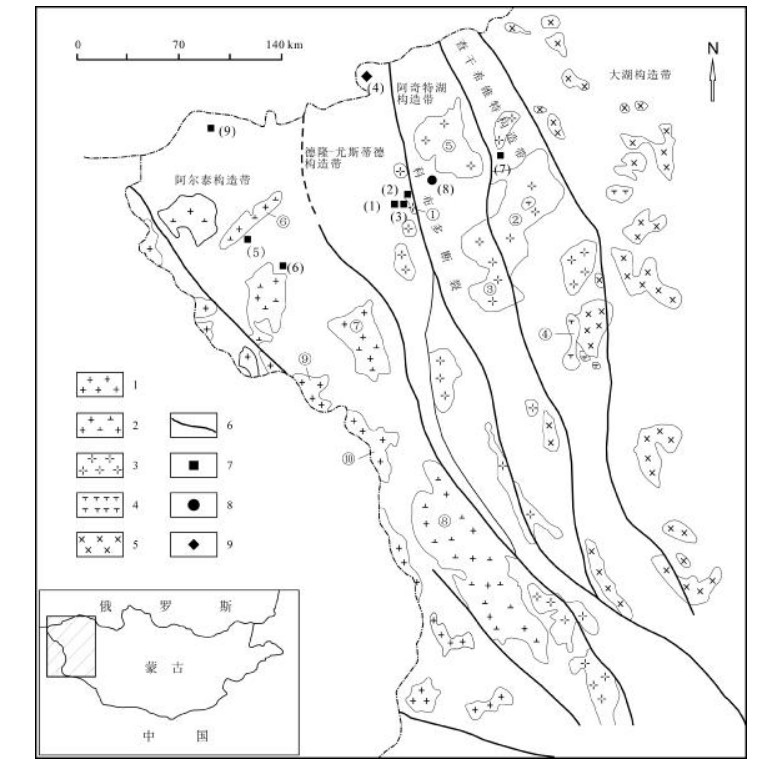
 下载:
下载:
